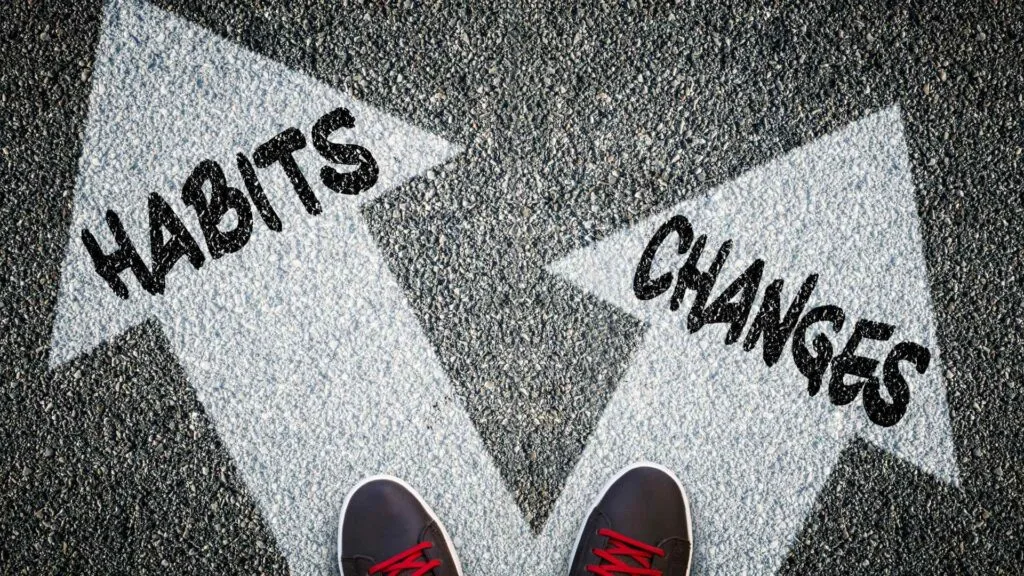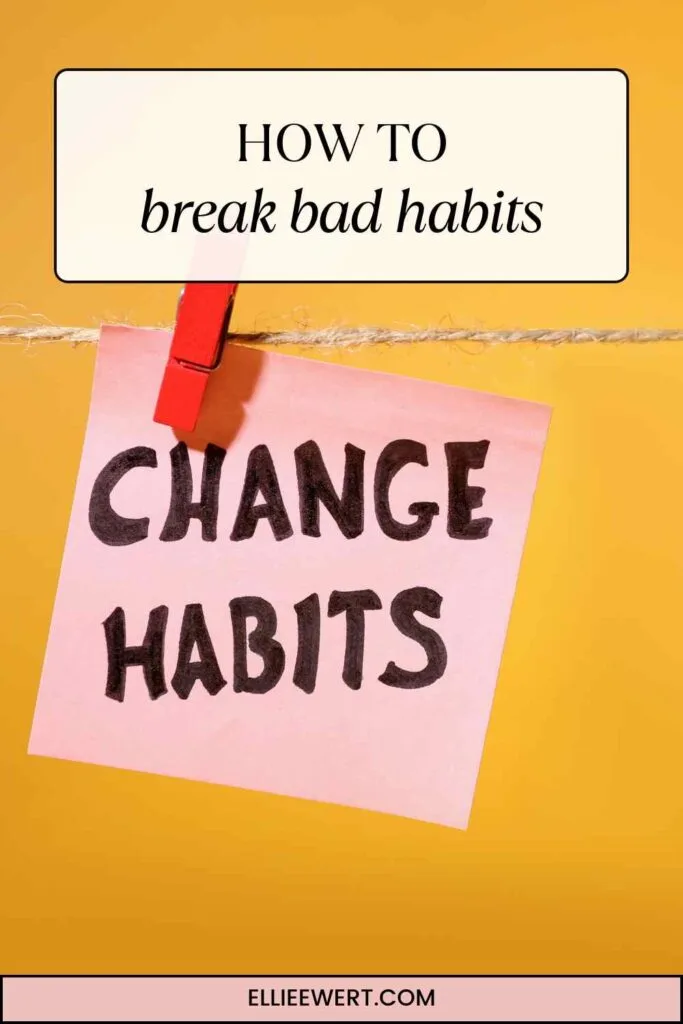We all have bad habits we’d like to kick. Whether it’s procrastination, unhealthy eating, or smoking, breaking these habits can feel daunting.
But don’t worry—this guide will provide you with practical strategies, tips, and encouragement to help you break free and start living a healthier, more fulfilling life.
Understanding Habits
Definition of a Habit
A habit is a routine behavior that is repeated regularly and tends to occur subconsciously.
These actions become automatic responses to specific situations, often driven by triggers or cues in our environment.
For instance, reaching for your phone first thing in the morning is a habit formed through repetition.
The Habit Loop
To understand how habits work, it’s essential to grasp the concept of the habit loop, which consists of three components:
- Cue: A trigger that initiates the behavior. This could be a specific time of day, an emotional state, or an environmental factor.
- Routine: The behavior itself, which can be physical, mental, or emotional.
- Reward: The positive outcome or feeling that follows the behavior, reinforcing the habit.
For example, if stress (cue) leads you to smoke a cigarette (routine), and it helps you feel relaxed (reward), you’re likely to repeat this behavior whenever you feel stressed.
Good vs. Bad Habits
Not all habits are harmful; in fact, many can be beneficial. Here’s how to distinguish between good and bad habits:
- Good Habits:
- Exercising regularly
- Eating healthy meals
- Practicing mindfulness or meditation
- Maintaining a consistent sleep schedule
- Bad Habits:
- Smoking
- Procrastination
- Overeating junk food
- Spending too much time on social media
Good habits contribute positively to your physical, mental, and emotional well-being, while bad habits can hinder your progress and lead to negative outcomes.
Understanding the nature of habits and how they form is the first step towards making meaningful changes in your life. In the next section, we’ll explore how to identify the bad habits that are holding you back and begin the journey to break free from them.

Identifying Your Bad Habits
Self-Reflection
The first step in breaking bad habits is recognizing them. This involves a bit of self-reflection. Take some time to think about your daily routines and behaviors. Ask yourself:
- What habits do I engage in regularly?
- Are there actions I take that I know are not good for me?
- How do I feel after performing these actions?
Keeping a journal can be helpful. Write down your thoughts and observations about your habits, noting when and why they occur. This can provide valuable insights into your patterns of behavior.
Common Bad Habits
Here are some common bad habits that many people struggle with:
- Smoking: A highly addictive habit that poses severe health risks.
- Procrastination: Putting off important tasks until the last minute.
- Unhealthy Eating: Consuming too much junk food or overeating.
- Excessive Screen Time: Spending too much time on phones, tablets, or computers.
- Nail Biting: A common nervous habit that can damage your nails and skin.
- Lack of Exercise: Neglecting physical activity, leading to poor health.
The Impact of Bad Habits
Bad habits can have a significant impact on various aspects of your life, including:
- Health: Smoking, poor diet, and lack of exercise can lead to serious health issues like heart disease, obesity, and diabetes.
- Productivity: Procrastination and excessive screen time can hinder your ability to accomplish important tasks, affecting your work or studies.
- Relationships: Habits like constant phone use or excessive drinking can strain your relationships with family and friends.
- Mental Well-Being: Negative habits can contribute to stress, anxiety, and depression, making it harder to enjoy life.
Recognizing the detrimental effects of your bad habits can be a strong motivator to change. In the next section, we’ll explore why breaking bad habits can be challenging and what makes these behaviors so hard to shake.

Why It’s Hard to Break Bad Habits
The Science Behind Habits
Breaking bad habits can be challenging due to the way our brains are wired. Habits are deeply embedded in the brain’s neural pathways.
When you repeat a behavior, your brain forms a connection that makes it easier to perform that behavior in the future.
Over time, these connections become stronger, making the habit more automatic.
- Neural Pathways: Habits are stored in the basal ganglia, a part of the brain associated with emotions, memories, and pattern recognition. Once a habit is established, the brain doesn’t need to work as hard to perform the behavior, making it automatic.
- Dopamine Release: Engaging in certain habits, especially those that provide immediate pleasure or relief, releases dopamine, a “feel-good” neurotransmitter. This creates a reward cycle that reinforces the habit.
Comfort Zones
Habits often provide a sense of comfort and security because they are familiar. This is why we tend to stick to them, even when they are bad for us. Stepping out of your comfort zone to change a habit requires effort and can be uncomfortable.
- Predictability: Habits create a predictable routine that your brain finds comforting. Change introduces uncertainty, which can be unsettling.
- Routine and Ritual: Many habits are tied to daily routines and rituals, making them feel like an integral part of your day.
Instant Gratification
Bad habits often provide immediate gratification, which makes them hard to resist. Our brains are wired to seek out rewards, and when a habit delivers quick pleasure or relief, it becomes highly reinforcing.
- Short-Term Pleasure: Bad habits like smoking, overeating, or excessive screen time offer instant pleasure, making it difficult to focus on the long-term consequences.
- Delayed Consequences: The negative effects of bad habits, such as health problems or decreased productivity, often don’t manifest immediately. This delay makes it easy to ignore the potential harm.
Understanding these challenges is crucial because it helps you approach habit-breaking with realistic expectations and strategies. In the next section, we’ll discuss effective strategies to overcome these hurdles and successfully break bad habits.
Strategies to Break Bad Habits
Set Clear Goals
Setting clear and achievable goals is essential for breaking bad habits. Having a specific target helps you stay focused and motivated.
- SMART Goals: Ensure your goals are Specific, Measurable, Attainable, Relevant, and Time-bound. For example, instead of saying, “I want to stop procrastinating,” set a goal like, “I will spend 30 minutes each day on my project work without distractions.”
- Write It Down: Document your goals to make them feel more real and to hold yourself accountable.
Identify Triggers
Understanding what triggers your bad habits is crucial. Identifying these triggers allows you to create strategies to avoid or manage them.
- Common Triggers: Stress, boredom, specific times of day, social situations, and certain emotions can all trigger bad habits.
- Track Your Triggers: Keep a diary of when and where your bad habits occur. Note your thoughts, feelings, and surroundings. Patterns will emerge that can help you understand your triggers.
Replace Bad Habits with Good Ones
One effective strategy is to replace a bad habit with a healthier or more productive behavior. This way, you’re not just trying to stop a habit but are actively creating a positive one.
- Substitution Examples:
- Replace smoking with chewing gum or deep breathing exercises.
- Replace snacking on junk food with eating fruits or vegetables.
- Replace procrastination with a brief exercise routine or a quick walk.
Gradual Changes
Making gradual changes can be more sustainable than attempting drastic overhauls. Small, incremental steps can lead to lasting change.
- Start Small: Break your goal into smaller, manageable tasks. For instance, if you want to reduce your screen time, start by cutting back 10 minutes each day.
- Build Momentum: As you achieve small successes, you’ll build confidence and motivation to tackle larger changes.
Practical Tips and Techniques
Mindfulness and Awareness
Staying present and conscious of your actions can help you break the cycle of bad habits.
- Mindfulness Practices: Techniques like meditation, deep breathing, and mindful eating can help you become more aware of your behaviors and triggers.
- Pause and Reflect: Before engaging in a bad habit, take a moment to pause and consider why you’re doing it and how you’ll feel afterward.
Create a Plan
Having a detailed plan can guide you through the process of breaking a bad habit.
- Action Steps: Outline specific steps you need to take to achieve your goal. Include potential obstacles and how you’ll overcome them.
- Timeline: Set a realistic timeline for your goals and monitor your progress regularly.
Use Reminders and Alerts
Visual and auditory cues can help you stay on track with your habit-breaking efforts.
- Sticky Notes: Place notes in visible areas reminding you of your goals.
- Alarms and Notifications: Use your phone or other devices to set reminders for positive behaviors or to avoid triggers.
Accountability
Involving others can provide additional motivation and support.
- Tell Friends and Family: Share your goals with people who can offer encouragement and hold you accountable.
- Support Groups: Join groups or online communities where members are working on similar goals.
Reward System
Celebrating your progress, no matter how small, can keep you motivated.
- Small Rewards: Treat yourself to something enjoyable after reaching a milestone, such as watching a favorite movie or having a special meal.
- Track Progress: Keep a chart or journal of your achievements and reward yourself for consistency.
By implementing these strategies, you can effectively work towards breaking your bad habits. In the next section, we’ll discuss how to overcome common obstacles that might arise during this journey.

Overcoming Obstacles
Dealing with Cravings and Temptations
Cravings and temptations are inevitable when trying to break a bad habit. Developing strategies to manage them is key to staying on track.
- Delay Technique: When you feel the urge to engage in a bad habit, delay it for 10 minutes. Often, the craving will pass or become more manageable.
- Distraction: Engage in a different activity to take your mind off the craving. For example, go for a walk, read a book, or call a friend.
- Visualize Success: Picture yourself overcoming the temptation and enjoying the benefits of breaking the habit. Visualization can strengthen your resolve.
Managing Stress
Stress is a common trigger for many bad habits. Finding healthy ways to cope with stress can prevent you from falling back into old patterns.
- Exercise: Physical activity is a great stress reliever. Find an exercise you enjoy, whether it’s yoga, running, or dancing.
- Relaxation Techniques: Practices like deep breathing, meditation, and progressive muscle relaxation can help reduce stress.
- Hobbies: Engage in activities you enjoy, such as painting, gardening, or playing an instrument, to distract yourself from stress.
Relapse and Setbacks
Relapses and setbacks are part of the process of breaking bad habits. How you handle them can determine your long-term success.
- Accept Imperfection: Understand that setbacks are normal and don’t mean you’ve failed. Use them as learning experiences.
- Analyze the Setback: Reflect on what triggered the relapse and how you can avoid similar situations in the future.
- Get Back on Track: Don’t let a setback derail your progress. Recommit to your goals and resume your efforts immediately.
By developing effective strategies to manage cravings, stress, and setbacks, you can navigate the challenges of breaking bad habits more successfully. In the next section, we’ll explore various tools and resources that can support you on your journey.
Tools and Resources
Apps and Technology
Leveraging technology can make breaking bad habits easier by providing structure and support.
- Habit-Tracking Apps:
- Habitica: Turns habit-building into a game, making it fun and engaging.
- Streaks: Helps you form good habits by tracking your daily progress and maintaining streaks.
- Quit Genius: Specifically designed to help people quit smoking through personalized plans and behavioral therapy.
- Mindfulness Apps:
- Headspace: Offers guided meditation and mindfulness exercises to help manage stress and cravings.
- Calm: Provides resources for relaxation and mindfulness, including sleep stories and breathing exercises.
Books and Articles
Reading about habit formation and behavior change can provide deeper insights and additional strategies.
- Books:
- “The Power of Habit” by Charles Duhigg: Explores the science behind habits and how to change them.
- “Atomic Habits” by James Clear: Offers practical advice on building good habits and breaking bad ones through small, incremental changes.
- “Breaking the Habit of Being Yourself” by Dr. Joe Dispenza: Combines scientific principles with practical exercises to help you break free from negative behaviors.
- Articles:
- Look for articles on reputable psychology and self-help websites, such as Psychology Today, to find tips and research-backed strategies for habit change.
Support Systems
Having a strong support system can make a significant difference in your success.
- Support Groups:
- Local Groups: Many communities have support groups for various habits, such as smoking cessation or overeating.
- Online Communities: Websites like Reddit, Facebook, and specialized forums offer communities where you can share experiences and receive support.
- Therapy and Counseling:
- Cognitive Behavioral Therapy (CBT): A type of therapy that can help you understand and change the thought patterns that drive your bad habits.
- Professional Counseling: Working with a therapist can provide personalized support and strategies tailored to your specific needs.
By utilizing these tools and resources, you can bolster your efforts to break bad habits and find the support you need to succeed. In the next section, we’ll look at inspiring success stories of people who have overcome their bad habits and what we can learn from their journeys.

Success Stories
Real-Life Examples
Hearing about others who have successfully broken their bad habits can be incredibly motivating. Here are some inspiring success stories:
- John’s Journey to Quit Smoking: John had been a smoker for over 20 years. After numerous failed attempts, he decided to join a local support group and use a habit-tracking app. By setting small, achievable goals and rewarding himself for progress, he gradually reduced his cigarette intake and eventually quit altogether. His story highlights the power of community support and the importance of celebrating small victories.
- Maria’s Battle with Procrastination: Maria was a chronic procrastinator, constantly delaying important tasks until the last minute. She started by identifying her triggers, which included stress and a lack of clear goals. Maria used a combination of mindfulness techniques and a detailed action plan to stay focused. By breaking tasks into smaller, manageable steps and setting daily priorities, she transformed her work habits and significantly improved her productivity.
- Sarah’s Success in Overcoming Unhealthy Eating: Sarah struggled with unhealthy eating habits for years, often turning to junk food for comfort. She began her journey by keeping a food diary to track her eating patterns and identify triggers. Sarah then replaced her unhealthy snacks with nutritious alternatives and joined an online community for additional support. By making gradual changes and staying accountable, she developed healthier eating habits and improved her overall well-being.
Lessons Learned
These success stories offer valuable lessons for anyone looking to break bad habits:
- Community Support: Engaging with support groups or online communities can provide encouragement and accountability, making it easier to stay on track.
- Small Steps: Setting small, achievable goals helps build momentum and makes the process less overwhelming.
- Self-Awareness: Identifying triggers and understanding the underlying reasons for bad habits are crucial for developing effective strategies to overcome them.
- Consistency: Regularly tracking progress and maintaining a consistent effort, even when facing setbacks, is key to long-term success.
By learning from these real-life examples, you can gain insights and inspiration to help you on your journey to break bad habits. In the next section, we’ll discuss how to maintain your progress and ensure your bad habits don’t return.
Conclusion
Breaking bad habits is a challenging but immensely rewarding journey. It requires self-awareness, persistence, and the willingness to step out of your comfort zone.
Throughout this guide, we’ve explored the nature of habits, identified strategies to overcome them, and provided practical tools and resources to support you along the way.
Recap of Key Points
- Understanding Habits: Recognize the components of habits and how they form to gain better control over them.
- Identifying Bad Habits: Reflect on your behaviors, track your triggers, and understand the impact of your bad habits on your life.
- Why It’s Hard to Break Habits: Acknowledge the brain’s role, comfort zones, and the allure of instant gratification.
- Strategies to Break Bad Habits: Set clear goals, identify triggers, replace bad habits with good ones, and make gradual changes.
- Practical Tips and Techniques: Use mindfulness, create a plan, set reminders, involve others for accountability, and reward yourself.
- Overcoming Obstacles: Develop strategies to manage cravings, handle stress, and recover from setbacks.
- Tools and Resources: Utilize apps, read relevant books and articles, and seek support systems.
- Success Stories: Draw inspiration and lessons from real-life examples of people who have successfully broken their bad habits.
Encouragement and Motivation
Remember, breaking a bad habit is a process that takes time and effort. It’s important to be patient with yourself and celebrate each small victory along the way.
Setbacks are a natural part of the journey, but with determination and the right strategies, you can overcome them and achieve lasting change.
Call to Action
Take the first step today. Reflect on your habits, set a clear goal, and start implementing the strategies you’ve learned.
Reach out for support if you need it, and don’t hesitate to use the tools and resources available to you. Every step you take brings you closer to a healthier, happier, and more fulfilling life.
Breaking bad habits is not just about eliminating negative behaviors; it’s about creating a better version of yourself. Embrace the journey, stay committed, and watch as positive changes unfold in your life. You’ve got this!


